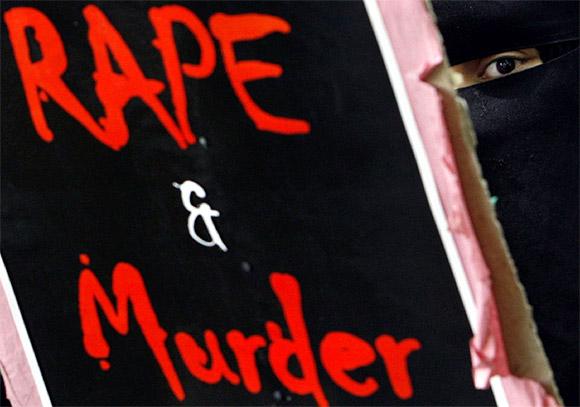Photographs: Fayaz Kabli/Reuters
There is an unwillingness to articulate what the statistics scream since the data indicts holy cows like family and society, says Devangshu Datta
In India, the profile of a likely rape victim is supposedly a lone woman, dressed 'immodestly', out at night with strangers
Los Angeles, June 18, 1964. Juanita Brooks' purse was snatched by a white woman with a blonde ponytail, who escaped in a yellow convertible driven by a bearded, black man. Some days later, the police arrested Janet and Malcolm Collins, who fitted the description and had a yellow convertible.
Witnesses couldn't identify them. The jury convicted on a statistical premise. The prosecution said that only one in ten (1/10) cars in Los Angeles was a yellow convertible, only one in three (1/3) women was blonde, only one in ten had ponytails, only one in four men had facial hair, only 1/1,000 Los Angeles couples were interracial, and so on. Compounding, roughly one out of a million couples (0.8/1,000,000) would fit.
California's Supreme Court rightly reversed the verdict. Los Angeles housed several million couples in 1964. Assuming the data were correct, quite a few other pairs fitted.
Click on NEXT for more...
Racial profiling to identify likely rape victim
Photographs: Nita Bhalla/Reuters
Statistics are egregiously used and misused in law enforcement. Racial profiling to identify potential terrorists, and indeed all profiling, is based on statistical assumption. In India, the profile of a likely rape victim is supposedly a lone woman, dressed "immodestly", out at night with strangers.
For example, the Haryana police believe that women who go out alone after 8 p m are at risk. The commissioner of Delhi police has suggested that women should take a driver or brother along if they go out.
West Bengal Sports Minister Madan Mitra blamed a victim for going alone to a nightclub and talking to strangers. C C Patil, the porn-surfing former Karnataka minister for women and child welfare, fulminated that women IT workers "should know how much skin to cover".
Is the profile accurate? Check the assertions against National Crime Records Bureau statistics. That data, collected thana by thana from the police, suggest a huge disconnect between perception and fact.
Click on NEXT for more...
Acquaintances outnumber strangers in rape cases
Photographs: Adnan Abidi/Reuters
The dichotomy may, perhaps, arise from a focus on the spectacular. A rape by a stranger in a moving car gets more headlines. Or perhaps there is an unwillingness to articulate what the statistics scream, since the data indict holy cows like family and society.
First, abandon the stranger-equals-rapist hypothesis. In 2010, there were a total of 22,193 victims of reported rape. As many as 21,566 -- that is 97.3 per cent -- were raped by men they knew. When it comes to rape offenders, acquaintances outnumber strangers by 36 to one.
A woman accompanied by her brother or driver may be at greater risk than one who goes out alone. In 2010, there were 288 cases of incest-rape by close family members. More distant relatives committed 1,344 rapes. That adds up to 7.5 per cent of family rapes. Another 7,816 rapes were committed by neighbours -- that is 36.2 per cent.
Click on NEXT for more...
To minimise chances of rape, DON'T use public toilets
Photographs: Reuters
Put together, family and neighbours are offenders in almost 44 per cent of rapes and about 16 times as likely to commit rape compared to a stranger. This also suggests home and neighbourhood are far more dangerous locations than nightclubs. Outside the home, the most common location for urban rape is apparently in the vicinity of a communal toilet in a jhuggi-jhopri colony.
In gang rapes (multiple perpetrators and victims), another pattern emerges. Gang rape is driven by caste or communal factors. It is often perpetrated by higher castes on lower castes. It's part and parcel of communal riots. The data are spotty -- not every state has them. Allegedly, rapes are also committed often by security forces in insurgency-hit parts. But these data are outside the purview of NCRB because cases are rarely registered.
The data suggest low-risk behaviour patterns that would minimise the chance of being raped. Women should avoid being born low-caste. They mustn't live in insurgency-hit areas. They should shun family and neighbours like the plague. They mustn't use public toilets. And, if possible, they should emigrate.
Click on NEXT for more...






article